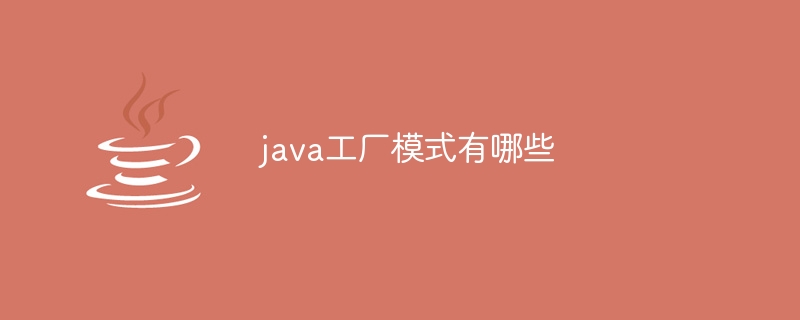Java factory patterns include simple factory pattern, factory method pattern and abstract factory pattern. These patterns are all creational design patterns, which aim to decouple object creation logic from client code and improve the flexibility and maintainability of the code. Detailed introduction: 1. Simple factory pattern, which is the most basic factory pattern, including simple factory roles, abstract product roles and specific product roles; 2. Factory method pattern, by defining a factory interface and multiple specific factory implementation classes, Realized the decoupling of client and specific product class; 3. Abstract factory pattern, etc.

The operating system for this tutorial: Windows 10 system, DELL G3 computer.
Java factory pattern mainly includes three types: simple factory pattern, factory method pattern and abstract factory pattern. These patterns are creational design patterns, which aim to decouple object creation logic from client code and improve the flexibility and maintainability of the code.
1. Simple factory pattern: This is the most basic factory pattern, including simple factory roles, abstract product roles and specific product roles. The simple factory class has the necessary logical judgment capabilities and the right to create all products, and can create different product objects according to the needs of the client. The simple factory pattern has a simple structure, but the structure in the state is the simplest.
2. Factory method pattern: By defining a factory interface and multiple specific factory implementation classes, the client is decoupled from specific product classes. The client only needs to know the interface or parent class of the required product, and does not need to care about the class of the specific product. Each concrete factory class is responsible for implementing the methods defined in the interface or abstract class and creating instances of the corresponding concrete product class. In this way, client code only needs to rely on abstract interfaces or abstract classes, which enhances the flexibility and maintainability of the system.
3. Abstract Factory Pattern: This is a more advanced factory pattern that provides best practices for product family creation. It decouples the client from the specific product family by defining an abstract factory interface and multiple concrete factory implementation classes. Each concrete factory class is responsible for creating instances of different concrete product objects of the same abstract product family. In this way, the client code only needs to rely on the abstract factory interface and does not need to care about the creation details of specific products.
These three factory patterns are gradually abstracted from top to bottom and become more general. When choosing which factory mode to use, you need to decide based on actual needs and application scenarios. The simple factory pattern is suitable for scenarios where there is only one specific product class; the factory method pattern is suitable for scenarios where there are multiple specific product classes in a product family; and the abstract factory pattern is suitable for scenarios where there are multiple product families in a product family, and each There are multiple product-specific scenarios in a product family.
In addition to the above three factory patterns, there is also a classification method that mixes the simple factory pattern and the factory method pattern. In this classification method, the simple factory pattern is regarded as a special case of the factory method pattern, that is, a scenario where there is only one specific factory implementation class. Therefore, these two modes are grouped together.
In short, the Java factory pattern is an important part of the creational design pattern, and they play an important role in software development. By rationally using these factory patterns, the quality, maintainability and reusability of the code can be effectively improved, making the software system more flexible, scalable and easier to maintain.
The above is the detailed content of What are the java factory patterns?. For more information, please follow other related articles on the PHP Chinese website!